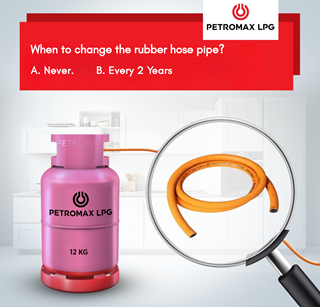When to change rubber hose pipe of an lpg cylinder
LPG (liquefied petroleum gas) is widely used in Bangladesh for cooking and heating, and Petromax LPG is one of the trusted brands providing high-quality gas cylinders. However, a critical yet often overlooked component of any LPG setup is the rubber hose that connects the cylinder to appliances. Over time, this hose can degrade, leading to potential gas leaks and safety hazards. This guide will help Petromax LPG consumers understand when to replace their LPG hose, how to detect issues, and how to ensure their system remains safe and efficient.
Why is It Important to Change the Rubber Hose of Your LPG Cylinder?
The rubber hose is responsible for transferring gas from the cylinder to your stove or other appliances. Over time, exposure to heat, sunlight, chemicals, and general wear can lead to cracks, leaks, or even ruptures. A worn-out hose can lead to dangerous gas leaks, which pose significant fire or explosion risks. Therefore, regular inspections and timely replacements are crucial to your safety.
What is the Lifespan of an LPG Hose?
The lifespan of an LPG hose is influenced by several factors, including usage, environmental conditions, and the quality of the hose itself. In Bangladesh, it is generally advised to replace the rubber hose every 2 to 3 years, depending on the type of use and the appliance connected. For Petromax LPG consumers, it is recommended to follow these guidelines:
- For regular home cooking use: Replace the hose every 10 years.
- For heavy or commercial use (e.g., restaurants): Replace the hose every 5 years.
These intervals help to ensure that the hose remains safe and functional, preventing potential gas leaks that might occur.
How to Identify LPG Hose Damage: Signs That Indicate Your LPG Hose Needs Replacing?
To prevent serious hazards, it's important to regularly inspect your LPG hose. Here are key signs that your LPG hose may need replacing:
- Cracks, Cuts, and Abrasions: Check for visible cracks or cuts along the surface of the hose. These can develop over time, especially if the hose is exposed to sunlight or extreme heat.
- Flattening or Kinking: A hose that has been repeatedly bent or flattened is more likely to develop leaks. Ensure the hose maintains its shape and flexibility.
- Softening or Hardening of Rubber: Over time, rubber hoses can become either too soft or too brittle, both of which compromise their effectiveness. Softness could mean the hose is swollen from heat, while brittleness suggests it's losing flexibility.
- Gas Odor: A strong, unpleasant gas smell near the hose is a clear indication that there may be a leak, requiring immediate replacement.
- Loose or Corroded Fittings: If the fittings that connect the hose to the LPG cylinder or appliance show signs of rust or loosening, it’s important to replace them to avoid gas leaks.
Does Exposure to Heat Shorten the Life of the LPG Hose?
Yes, heat is one of the biggest factors that degrade the rubber in LPG hoses. In Bangladesh’s tropical climate, the combination of high temperatures and humidity can speed up the process of wear and tear. Direct exposure to sunlight, hot surfaces, or appliances can cause the rubber to harden or crack. To extend the life of your hose, keep it away from heat sources and store it in a cool, dry place whenever possible.
Can Chemicals Damage the LPG Hose?
Yes, chemicals like oils, solvents, or even cleaning agents can damage the rubber. LPG hoses exposed to such substances may weaken, crack, or degrade faster. If your hose comes into contact with these chemicals, it’s important to inspect it regularly and replace it if necessary.
How Can You Properly Maintain Your LPG Hose?
Proper maintenance can significantly extend the lifespan of your LPG hose. Here are some tips to keep your hose in good condition:
- Monthly Inspections: Make a habit of checking the hose every month for visible damage like cracks, cuts, or signs of wear.
- Storage: When not in use, store the hose in a dry, cool place away from sunlight, chemicals, or sharp objects that could damage it.
- Avoid Sharp Objects: Ensure that the hose does not come into contact with sharp edges or rough surfaces, as these can lead to cuts or abrasions.
- Use Hose Protectors: Consider using a hose protector or cover to shield the hose from UV rays and environmental damage.
- Check Fittings: Periodically check the fittings for any signs of rust, wear, or loose connections. Tighten them securely to prevent gas leaks.
Are There Safety Standards for LPG Hoses in Bangladesh?
Yes, LPG hoses in Bangladesh must meet certain safety standards to ensure they are durable and safe to use. The Bangladesh Standard BDS 651 specifies the requirements for LPG hoses, including material quality, pressure tolerance, and resistance to heat and chemicals. Always make sure your LPG hose is compliant with these standards for maximum safety.
Conclusion: Prioritize Safety with Regular LPG Hose Replacement
The rubber hose of your LPG cylinder is a crucial component that ensures safe and efficient gas flow. For Petromax LPG consumers in Bangladesh, replacing the hose at the right time and maintaining it properly will minimize the risk of leaks, fire, and other hazards. By following the recommended replacement intervals, identifying early signs of damage, and adhering to proper maintenance practices, you can ensure the safety of your household or business for years to come.
Sources:

